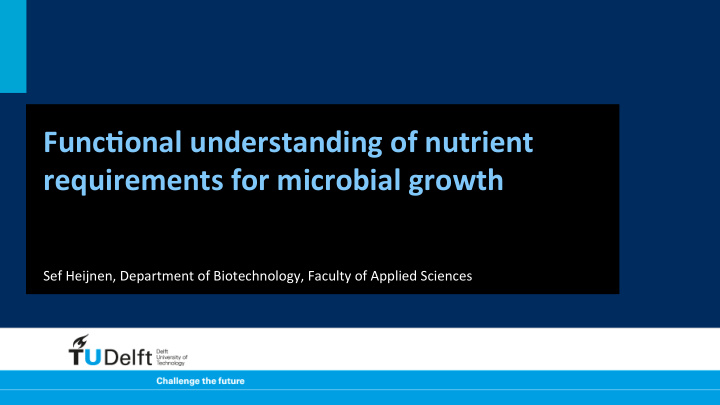



Func%onal ¡understanding ¡of ¡nutrient ¡ requirements ¡for ¡microbial ¡growth ¡ Sef ¡Heijnen, ¡Department ¡of ¡Biotechnology, ¡Faculty ¡of ¡Applied ¡Sciences ¡
Growth ¡by ¡Division ¡
Growth ¡Medium Typical nutrients needed for Growth • Water ¡ ¡ ¡ • ¡Glucose ¡ • ¡Ammonia ¡ • ¡Sulphate ¡ • ¡Phosphate Why ¡These ¡Nutrients? ¡
Cell ¡Composi%on Organic ¡23% ¡ Inorganic ¡2% ¡ Water ¡75% ¡
Cell ¡Composi%on Organic 23% Small ¡Organic ¡ Lipids ¡ Polymers ¡ Carbohydrates ¡ Compounds ¡ -‑ReacLon ¡ -‑Membrane ¡ -‑DNA ¡ -‑Cell ¡Wall ¡ Intermediates ¡ -‑RNA ¡ -‑Storage ¡ -‑Cofactors ¡ -‑Proteins ¡ -‑Regulatory ¡ ¡ Factors ¡ -‑Vitamins ¡
Vitamins Incomplete ¡AcLve ¡Site ¡ Vitamin ¡ Enzyme ¡
Vitamins Complete ¡AcLve ¡Site ¡ Vitamin ¡ Enzyme ¡ Enzyme ¡
Cell ¡Composi%on Inorganic 2% Sulphate ¡ Magnesium Phosphate ¡ Potassium Trace Metals (Chloride) ¡ (Calcium)
Elemental ¡composi%on ¡of ¡dry ¡biomass ¡ ¡ • ¡1-‑Cmole ¡of ¡organic ¡dry ¡mass ¡(4 ¡elements) ¡ ¡ • ¡ ¡ ¡C 1 H 1.8 O 0.5 N 0.2 ¡ ¡ • 1-‑Cmole ¡of ¡dry ¡mass, ¡extended ¡with ¡macro ¡elements ¡(8 ¡elements) ¡ ¡ C 1 H 1.8 O 0.5 N 0.2 P 0.03 S 0.02 K 0.008 Mg 0.01 ¡ • • Trace ¡elements: ¡ ¡ Ca ¡(31×10 -‑6 ), ¡ Cu ¡(3×10 -‑6 ), ¡ Fe ¡(16×10 -‑6 ), ¡ ¡ ¡ ¡Mn ¡(23×10 -‑6 ), ¡ Zn ¡(385×10 -‑6 ), ¡ Na ¡(6521×10 -‑6 ) ¡ ¡
Anabolic ¡Reac%on ¡to ¡Produce ¡1 ¡Mol ¡Biomass ¡ • C 1 H 1.80 O 0.50 N 0.21 ¡ • Carbon ¡source: ¡Glucose ¡(C 6 H 12 O 6 ¡ ) ¡ • Nitrogen ¡source: ¡Ammonium ¡(NH 4 + ¡) ¡ • Always ¡contains ¡H 2 O, ¡CO 2 ¡ and ¡H + ¡ ¡ 0.175 ¡C 6 H 12 O 6 ¡ + ¡0.20 ¡NH 4 + ¡ ¡ à ¡ ¡1C 1 H 1.80 O 0.50 N 0.20 ¡ + ¡0.05 ¡CO 2 ¡ + ¡0.45 ¡H 2 O ¡+ ¡0.2 ¡H + ¡
Anabolism ¡ 0.175 ¡glucose ¡ 1 ¡mol ¡biomass ¡ (C-‑source) ¡ Energy ¡(ATP) ¡ Glucose ¡ CO 2 ¡ (Electron ¡donor) ¡ (Oxidized ¡electron ¡donor) ¡ O 2 ¡ H 2 O ¡ Catabolism ¡ (Electron ¡acceptor) ¡ (Reduced ¡electron ¡acceptor) ¡
Diversity ¡of ¡Catabolic ¡Reac%on ¡ Donor/Acceptor ¡ Oxidized ¡Donor/Reduced ¡Acceptor ¡ Glucose ¡+ ¡6 ¡O 2 ¡ 6 ¡CO 2 ¡+ ¡6 ¡H 2 O ¡ 3 ¡O 2 ¡ ¡ + ¡Ethanol ¡ ¡ 3 ¡CO 2 ¡+ ¡H 2 O ¡ Fe 2+ ¡+ ¡¼ ¡O 2 ¡+ ¡H + ¡ Fe 3+ ¡+ ¡½ ¡H 2 O ¡ H 2 S ¡+ ¡½ ¡O 2 ¡ S 0 ¡+ ¡H 2 O ¡ H 2 S ¡+ ¡2 ¡O 2 ¡ SO 4 2-‑ ¡+ ¡2 ¡H + ¡ Glucose ¡ 2 ¡ethanol ¡+ ¡2 ¡CO 2 ¡ 5 ¡H 2 S ¡ + ¡8 ¡HNO 3 ¡ ¡ 4 ¡N 2 ¡+ ¡5 ¡H 2 SO 4 ¡+ ¡4H 2 O ¡ 1½ ¡O 2 ¡ + ¡NH 4 + ¡ ¡ NO 2 -‑ ¡+ ¡2H + ¡+ ¡H 2 O ¡
Quan%ta%ve ¡Picture ¡of ¡Nutrients/Products ¡ C 6 H 12 O 6 (C-source) C 6 H 12 O 6 (Electron donor) H 2 O H + O 2 (Electron acceptor) NH 4 + (N-source) H 2 PO 4 - CELL C 1 H 1.80 O 0.50 N 0.20 (Biomass) SO 4 2- CO 2 K + C 3 H 8 O 2 Vitamins Mg 2+ Trace elements (Product: PDO)
See ¡you ¡in ¡the ¡next ¡unit! ¡
Recommend
More recommend